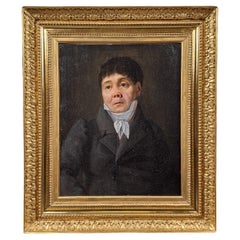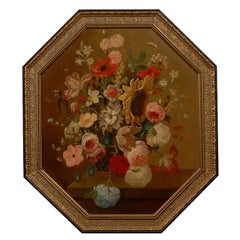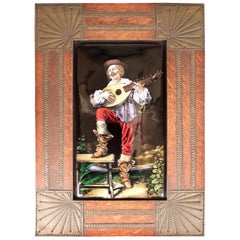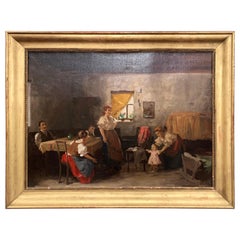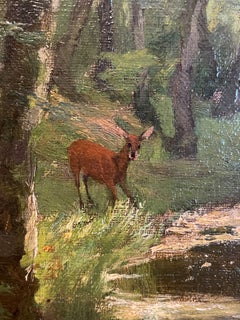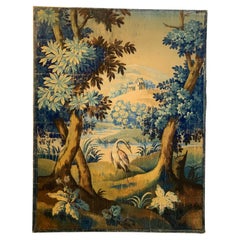Restauration Paintings
6
to
3
3
6
6
6
2,824
2,663
707
402
374
303
242
192
111
88
68
61
61
52
48
43
37
29
6
Height
to
Width
to
4
4
2
1
1
6
6
Style: Restauration
Oil On Canvas - Portrait Of A Man - Restauration Period
Located in BARSAC, FR
Portrait of a man with unsightly features and sad and melancholy looks.
Beautiful atypical work, very brilliantly executed.
In an old frame entirely gilded with gold leaf.
Very go...
Category
Early 19th Century French Antique Restauration Paintings
Materials
Canvas
Virgin and Child "after Raphael, France About 1820
Located in PARIS, FR
Oil on canvas portraying a part of Raphael's great painting "The Sistine Madonna", kept at the Gemäldegalerie in Dresden, dated 1512.
This painting is typical of the movement to revi...
Category
1820s French Antique Restauration Paintings
Materials
Canvas
French 19th Century Oil on Canvas Floral Painting circa 1830 in Gilt Frame
Located in Atlanta, GA
A French Restauration period oil on canvas still-life floral painting from the 19th century, in giltwood frame. Born in France during the second quarter of the 19th century, this floral painting captures our attention with its lovely colors and romantic depiction of a luscious bouquet of flowers standing out on an outdoors scene. Red, orange, white, brown, green and blue tones among others are playing with one another beautifully. Set inside a new gilded and carved frame, this French floral oil...
Category
Mid-19th Century French Antique Restauration Paintings
Materials
Canvas, Giltwood
Pair of Restauration style reverse glass paintings, late 19th century
Located in Saint-Ouen, FR
Pair of French Restauration style rectangular reverse glass paintings representing baskets of flowers on a white background, one of peonies one of roses. The whole ensemble has a fir...
Category
1880s French Antique Restauration Paintings
Materials
Glass
19th Century French Painting
Located in Belmont, MA
19th century French painting, signed: "M.J.Metz", oil on metal, size with frame: 15.5 x 13.7 inches (38.5 x 35 cm).
Category
1850s French Antique Restauration Paintings
French Restauration Period 1820s Framed Octagonal Painting Depicting a Bouquet
Located in Atlanta, GA
A French Restauration period octagonal framed oil on canvas still-life painting from the early 19th century, depicting a bouquet of flowers. Born in France during the reign of King L...
Category
Early 19th Century French Antique Restauration Paintings
Materials
Paint, Canvas, Wood
Related Items
Fine Late 19th Century French Enamel Plaque
Located in New York, NY
A fine late 19th century French enamel plaque.
Depicting a man in leisure attire, playing his mandolin. Stamped TS on the bottom right.
Measur...
Category
Late 19th Century French Antique Restauration Paintings
Materials
Enamel
19th Century Hungarian Oil on Canvas Painting in Gilt Frame Signed & Dated, 1897
Located in Dallas, TX
Set in the original carved giltwood frame, the large antique painting was created in Hungary, circa 1897; the art work depicts a traditional interior scene with people and child eati...
Category
Late 19th Century Hungarian Antique Restauration Paintings
Materials
Canvas, Giltwood
H 29.75 in W 36.75 in D 1.75 in
Pair of Antique Oil/Canvas Paintings Depicting Horse and Mare, Signed/Framed
Located in Los Angeles, CA
A Pair of Antique Oil/Canvas Paintings Depicting Horse and Mare, signed on each painting, bottom left hand side. Both with identical frames. light scruff to one painting near the fra...
Category
Late 19th Century Antique Restauration Paintings
Materials
Canvas
H 21 in W 20.5 in D 3.5 in
After Raffaello Sanzio 1483-1520 Raphael La Madonna della Seggiola Oil on Canvas
Located in Los Angeles, CA
A fine Italian 19th century oil painting on canvas "La Madonna della Seggiola" after Raphael (Raffaello Sanzio da Urbino 1483-1520) The circular canvas depicting a seated Madonna holding an infant Jesus Christ next to a child Saint John the Baptist, all within a massive carved gilt wood and gesso frame (all high quality gilt is original) which is identical to the frame on Raphael's original artwork. This painting is a 19th Century copy of Raphael's Madonna della Seggiola painted in 1514 and currently exhibited and part of the permanent collection at the Palazzo Pitti, Galleria Palatina, Florence, Italy. The bodies of the Virgin, Christ, and the boy Baptist fill the whole picture. The tender, natural looking embrace of the Mother and Child, and the harmonious grouping of the figures in the round, have made this one of Raphael's most popular Madonnas. The isolated chair leg is reminiscent of papal furniture, which has led to the assumption that Leo X himself commissioned the painting, circa 1890-1900.
Subject: Religious painting
Measures: Canvas height: 29 1/4 inches (74.3 cm)
Canvas width: 29 1/4 inches (74.3 cm)
Painting diameter: 28 1/4 inches (71.8 cm)
Frame height: 57 7/8 inches (147 cm)
Frame width: 45 1/2 inches (115.6 cm)
Frame depth: 5 1/8 inches (13 cm).
Raffaello Sanzio da Urbino (Italian, March 28 or April 6, 1483 - April 6, 1520), known as Raphael, was an Italian painter and architect of the High Renaissance. His work is admired for its clarity of form, ease of composition, and visual achievement of the Neoplatonic ideal of human grandeur. Together with Michelangelo and Leonardo da Vinci, he forms the traditional trinity of great masters of that period.
Raphael was enormously productive, running an unusually large workshop and, despite his death at 37, leaving a large body of work. Many of his works are found in the Vatican Palace, where the frescoed Raphael Rooms were the central, and the largest, work of his career. The best known work is The School of Athens in the Vatican Stanza della Segnatura. After his early years in Rome much of his work was executed by his workshop from his drawings, with considerable loss of quality. He was extremely influential in his lifetime, though outside Rome his work was mostly known from his collaborative printmaking.
After his death, the influence of his great rival Michelangelo was more widespread until the 18th and 19th centuries, when Raphael's more serene and harmonious qualities were again regarded as the highest models. His career falls naturally into three phases and three styles, first described by Giorgio Vasari: his early years in Umbria, then a period of about four years (1504–1508) absorbing the artistic traditions of Florence, followed by his last hectic and triumphant twelve years in Rome, working for two Popes and their close associates.
Raphael was born in the small but artistically significant central Italian city of Urbino in the Marche region, where his father Giovanni Santi was court painter to the Duke. The reputation of the court had been established by Federico III da Montefeltro, a highly successful condottiere who had been created Duke of Urbino by the Pope - Urbino formed part of the Papal States - and who died the year before Raphael was born. The emphasis of Federico's court was rather more literary than artistic, but Giovanni Santi was a poet of sorts as well as a painter, and had written a rhymed chronicle of the life of Federico, and both wrote the texts and produced the decor for masque-like court entertainments. His poem to Federico shows him as keen to show awareness of the most advanced North Italian painters, and Early Netherlandish artists as well. In the very small court of Urbino he was probably more integrated into the central circle of the ruling family than most court painters.
Federico was succeeded by his son Guidobaldo da Montefeltro, who married Elisabetta Gonzaga, daughter of the ruler of Mantua, the most brilliant of the smaller Italian courts for both music and the visual arts. Under them, the court continued as a centre for literary culture. Growing up in the circle of this small court gave Raphael the excellent manners and social skills stressed by Vasari. Court life in Urbino at just after this period was to become set as the model of the virtues of the Italian humanist court through Baldassare Castiglione's depiction of it in his classic work The Book of the Courtier, published in 1528. Castiglione moved to Urbino in 1504, when Raphael was no longer based there but frequently visited, and they became good friends. He became close to other regular visitors to the court: Pietro Bibbiena and Pietro Bembo, both later cardinals, were already becoming well known as writers, and would be in Rome during Raphael's period there. Raphael mixed easily in the highest circles throughout his life, one of the factors that tended to give a misleading impression of effortlessness to his career. He did not receive a full humanistic education however; it is unclear how easily he read Latin.
Early Life and Works
His mother Màgia died in 1491 when Raphael was eight, followed on August 1, 1494 by his father, who had already remarried. Raphael was thus orphaned at eleven; his formal guardian became his only paternal uncle Bartolomeo, a priest, who subsequently engaged in litigation with his stepmother. He probably continued to live with his stepmother when not staying as an apprentice with a master. He had already shown talent, according to Vasari, who says that Raphael had been "a great help to his father". A self-portrait drawing from his teenage years shows his precocity. His father's workshop continued and, probably together with his stepmother, Raphael evidently played a part in managing it from a very early age. In Urbino, he came into contact with the works of Paolo Uccello, previously the court painter (d. 1475), and Luca Signorelli, who until 1498 was based in nearby Città di Castello.
According to Vasari, his father placed him in the workshop of the Umbrian master Pietro Perugino as an apprentice "despite the tears of his mother". The evidence of an apprenticeship comes only from Vasari and another source, and has been disputed—eight was very early for an apprenticeship to begin. An alternative theory is that he received at least some training from Timoteo Viti, who acted as court painter in Urbino from 1495.Most modern historians agree that Raphael at least worked as an assistant to Perugino from around 1500; the influence of Perugino on Raphael's early work is very clear: "probably no other pupil of genius has ever absorbed so much of his master's teaching as Raphael did", according to Wölfflin. Vasari wrote that it was impossible to distinguish between their hands at this period, but many modern art historians claim to do better and detect his hand in specific areas of works by Perugino or his workshop. Apart from stylistic closeness, their techniques are very similar as well, for example having paint applied thickly, using an oil varnish medium, in shadows and darker garments, but very thinly on flesh areas. An excess of resin in the varnish often causes cracking of areas of paint in the works of both masters. The Perugino workshop was active in both Perugia and Florence, perhaps maintaining two permanent branches. Raphael is described as a "master", that is to say fully trained, in December 1500.
His first documented work was the Baronci altarpiece for the church of Saint Nicholas of Tolentino in Città di Castello, a town halfway between Perugia and Urbino. Evangelista da Pian di Meleto, who had worked for his father, was also named in the commission. It was commissioned in 1500 and finished in 1501; now only some cut sections and a preparatory drawing remain. In the following years he painted works for other churches there, including the Mond Crucifixion (about 1503) and the Brera Wedding of the Virgin (1504), and for Perugia, such as the Oddi Altarpiece. He very probably also visited Florence in this period. These are large works, some in fresco, where Raphael confidently marshals his compositions in the somewhat static style of Perugino. He also painted many small and exquisite cabinet paintings in these years, probably mostly for the connoisseurs in the Urbino court, like the Three Graces and St. Michael, and he began to paint Madonnas and portraits. In 1502 he went to Siena at the invitation of another pupil of Perugino, Pinturicchio, "being a friend of Raphael and knowing him to be a draughtsman of the highest quality" to help with the cartoons, and very likely the designs, for a fresco series in the Piccolomini Library in Siena Cathedral. He was evidently already much in demand even at this early stage in his career.
Influence of Florence
Raphael led a "nomadic" life, working in various centres in Northern Italy, but spent a good deal of time in Florence, perhaps from about 1504. Although there is traditional reference to a "Florentine period...
Category
19th Century Italian Antique Restauration Paintings
Materials
Gesso, Canvas, Wood
H 57.88 in W 45.5 in D 5.13 in
Pair of Late 19th Century Painted Decorative Italian Wall Panels
Located in Atlanta, GA
A very lovely pair of late 19th century painted decorative wall panels, Italian circa 1900. Charming romantic scenes painted on dense paper. These panels will be a delightful ornam...
Category
19th Century Italian Antique Restauration Paintings
Materials
Paper
Gemstone Painting of Mother and Child Styled After Elisabeth Vigee Le Brun
Located in Somis, CA
A gem studded masterpiece, modeled after Elisabeth Vigee Le Brun's 18th century self portrait with her daughter Julie, depicting the timeless bond between mother and child. Executed ...
Category
20th Century Italian Restauration Paintings
Materials
Multi-gemstone
The Virgin in the Chair (19th Century, after Raphael)
Located in Paris, FR
The Virgin in the Chair (Madonna della sedia) was painted by Raphael in 1513-1514, during his Roman period.
It represents Mary, holding the Child Jesus in her arms, and John the Bapt...
Category
19th Century Italian Antique Restauration Paintings
Materials
Wood
Mughal Style Watercolor on Paper Painting Depicting a Royal Court Scene, Framed
Located in Yonkers, NY
A small vintage Mughal style Indian painting depicting a royal court scene, in custom giltwood frame. This small vintage Mughal-style Indian painting is a captivating window into the...
Category
Mid-20th Century Indian Restauration Paintings
Materials
Glass, Giltwood, Paint, Paper
H 18.5 in W 14 in D 1 in
19th Century French Framed Impressionist Oil on Canvas
Located in Houston, TX
19th century French framed impressionist oil on canvas.
Stunning 19th century French framed impressionist oil on canvas. This beautiful French oi...
Category
1870s French Antique Restauration Paintings
Materials
Canvas, Wood
After Raffaello Sanzio 1483-1520 Raphael La Madonna Della Seggiola Oil on Canvas
Located in Los Angeles, CA
A fine Italian 19th century oil painting on canvas "La Madonna della Seggiola" after Raphael (Raffaello Sanzio da Urbino 1483-1520). The circular painted canvas depicting a seated Ma...
Category
Late 19th Century Italian Antique Restauration Paintings
Materials
Canvas, Giltwood
H 50.5 in W 46.63 in D 4.75 in
18th century French school, Virgin Mary and Jesus Child painting after Raphael
Located in GRENOBLE, FR
Late 18th century or early 19th century French school, antique painting featuring the Virgin Mary holding Jesus Child, Saint John the Baptist around.
Our work has been painted using ...
Category
Late 18th Century French Antique Restauration Paintings
Materials
Canvas, Paint
H 33.86 in W 29.14 in D 0.79 in
French Oil On Canvas Portrait of a Man c. 1800
Located in 263-0031, JP
French oil on canvas portrait of a man c. 1800. The bourgeois gent depicted here displays the cliched hand-in-waistcoat mannerism of the 18th and early 19th century. He’s wearing wha...
Category
Early 19th Century French Antique Restauration Paintings
Materials
Canvas
Previously Available Items
Roe Deer in the Woods Painting by Arthur Thiele
Located in Albignasego, IT
Arthur Thiele – Roe Deer in the Woods
47 x 39 cm without frame
61 x 54 cm with frame
Oil painting on canvas, dated 1876
Ancient painting, ...
Category
1870s German Antique Restauration Paintings
Materials
Canvas
circa 19th Century French Painted Forest View Cartoon for a Tapestry on Paper
Located in London, GB
A wonderful early 19th century French cartoon painting which is painted on thick paper and wood backed.
The painting is a scene of lake, hills and fore...
Category
1820s French Antique Restauration Paintings
Materials
Paper, Fabric, Wood, Paint
H 60.63 in W 46.46 in D 1.58 in
Women's Painting of Restoration Quality from the 1820s
Located in Saint-Ouen, FR
Painting on canvas,
Oil on canvas representing a lady of quality
École Française Epoque Restauration circa 1820,
19th century.
Measures: Width 53 cm / height 62cm with frame.
Category
1820s French Antique Restauration Paintings
Materials
Canvas
19th Century Painted Porcelain Plate with Asian Characters
Located in Paris, FR
Painted porcelain plate decorated with Asian characters posing in landscapes. The painstaking detail of the clothing and faces, the vibrancy of the colors and the intimate nature of ...
Category
Early 19th Century French Antique Restauration Paintings
Materials
Porcelain, Wood
Portrait of a Young Man by Willem Hendrik Schmidt, Dutch
Located in Dallas, TX
A beautifully painted realistic portrait of a young man with blond hair. The artist is Willem Hendrik Schmit (1809-1849, Dutch). He was a pupil of Gillis de Meijer. Image measurement...
Category
Mid-19th Century Dutch Antique Restauration Paintings
Materials
Canvas
Miniature Paintings by Miss Hyacinthe Mercier, French, 1808-1839
By Hyacinth Mercier
Located in Paris, FR
Early 19th century oval portrait miniature paintings depicting the Baron and Baroness Louis Jacques Amiot. These antique paintings are hou...
Category
Early 19th Century French Antique Restauration Paintings
Materials
Metal
19th Century Oil on Canvas Still Life Signed with Label in an Ebony & Gilt Frame
Located in Stamford, CT
A 19th century finely painted oil on canvas German in an ebony and gilt frame. This German painted signed and bearing a label on the reverse comes straight out of a NYC Brownstone. T...
Category
Late 19th Century German Antique Restauration Paintings
H 33.75 in W 28.75 in D 3 in
Signed 19th Century Oil on Canvas Boats in a Harbor
Located in Stamford, CT
A signed 19th century oil on canvas boats in a harbor. Set in a thick walnut frame this wonderfully detained oil on canvas shows steam boats as well ...
Category
Late 19th Century European Antique Restauration Paintings
Restauration paintings for sale on 1stDibs.
Find a broad range of unique Restauration paintings for sale on 1stDibs. Many of these items were first offered in the 19th Century, but contemporary artisans have continued to produce works inspired by this style. If you’re looking to add vintage paintings created in this style to your space, the works available on 1stDibs include wall decorations and other home furnishings, frequently crafted with canvas, fabric and other materials. If you’re shopping for used Restauration paintings made in a specific country, there are Europe, and France pieces for sale on 1stDibs. It’s true that these talented designers have at times inspired knockoffs, but our experienced specialists have partnered with only top vetted sellers to offer authentic pieces that come with a buyer protection guarantee. Prices for paintings differ depending upon multiple factors, including designer, materials, construction methods, condition and provenance. On 1stDibs, the price for these items starts at $1,394 and tops out at $5,950 while the average work can sell for $3,425.
Recently Viewed
View AllMore Ways To Browse
19th Century Antique Library Bookcases
Antique Hanging Wall Cabinet
Antique Small Crystal Chandelier
Antique Solid Walnut Writing Desk
Antique Walnut Bedside Cabinets
Antique Wooden Writing Table
Bank Chest
Black Gold Murano Glass Table Lamp
Black Painted Chinese Cabinet
Blue Painted Swedish Cabinet
Buddhist Flowers
Bureau Bookcase Antique
Cameo Glass Vases By Daum
Carved Spanish Desk
Chippendale China Cabinet
Italian Inlaid Marquetry Cabinet
Japanese Baluster Vase
Japanese Door Panels
